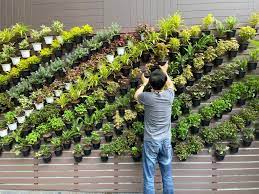1. Introduction
Vertical gardening is a gardening technique that involves growing plants vertically instead of horizontally. It’s an ideal solution for people with limited outdoor space or those who want to add a touch of greenery to their homes. In this article, we will delve into the world of vertical gardening and provide you with all the information you need to get started.
2. Benefits of Vertical Gardening
Vertical gardening offers several advantages, including maximizing space, improving air quality, and enhancing aesthetics. We will explore these benefits in detail to help you understand why vertical gardening is becoming increasingly popular.
3. Choosing the Right Wall
Not all walls are suitable for vertical gardening. We’ll discuss how to select the perfect wall for your garden, considering factors like sunlight exposure and wall material.
4. Selecting Plants for Vertical Gardens
The choice of plants plays a crucial role in the success of your vertical garden. Learn about the best plant options and their specific requirements for vertical growth.
5. Vertical Garden Design Ideas
Discover various design ideas to make your vertical garden visually appealing. From creating a living wall masterpiece to designing a herb garden, we’ve got design inspiration for everyone.
6. Creating a Vertical Garden Frame
To support your plants, you’ll need a sturdy frame. We’ll guide you through the process of constructing or purchasing a frame that suits your space and design preferences.
7. Planting Your Vertical Garden
Step-by-step instructions on how to plant your vertical garden for optimal growth and aesthetics. We’ll cover spacing, soil selection, and planting techniques.
8. Vertical Garden Maintenance
Vertical gardens require care and attention. Learn about maintenance routines, including pruning, fertilizing, and dealing with common issues.
9. Watering Techniques
Proper watering is crucial for the health of your vertical garden. We’ll share watering techniques that ensure your plants receive the right amount of moisture.
10. Light Requirements
Understanding the light needs of your plants is essential. We’ll discuss how to position your vertical garden to maximize sunlight and growth.
11. Dealing with Pests
Like any garden, vertical gardens can attract pests. Discover effective methods for pest control that won’t harm your plants or the environment.
12. Harvesting from Vertical Gardens
If you’re growing edible plants, harvesting is a rewarding part of vertical gardening. Learn when and how to harvest your crops for the best results.
13. Vertical Gardening in Small Spaces
Living in a small apartment or condo? We’ll provide tips and ideas for creating a vertical garden in even the tightest spaces.
14. Vertical Gardening DIY Projects
Get your hands dirty with some exciting DIY vertical gardening projects. From upcycled pallet gardens to innovative hanging planters, we’ve got creative ideas to inspire you.
15. Conclusion
In conclusion, vertical gardening is a versatile and space-saving way to introduce greenery into your life. Whether you have a sprawling backyard or a tiny balcony, vertical gardening allows you to harness the power of vertical space. Start your vertical garden today and enjoy the benefits of a lush, thriving oasis in your home.
FAQs
Q1: Can I use any wall for vertical gardening? A1: While many walls can be used, it’s essential to choose one with suitable sunlight and structural integrity.
Q2: What are some low-maintenance plants for vertical gardens? A2: Succulents, snake plants, and pothos are excellent choices for low-maintenance vertical gardens.
Q3: Do I need a green thumb to start vertical gardening? A3: No, vertical gardening is suitable for beginners and experienced gardeners alike, and it’s a great way to develop your gardening skills.
Q4: Can I grow vegetables vertically? A4: Absolutely! Many vegetables, such as tomatoes and peppers, thrive in vertical gardens.
Q5: How often should I water my vertical garden? A5: The frequency of watering depends on the plants and the environment, but generally, aim to keep the soil consistently moist without overwatering.



